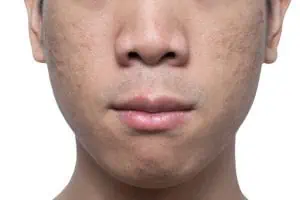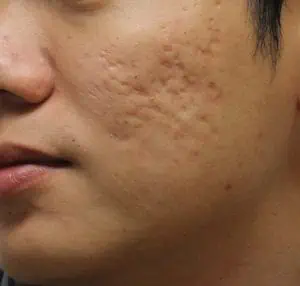
Acne is double trouble: First there’s the ugly blemishes. Then, in many cases, there are the scars that result. If you’re wondering whether it’s possible to get rid of acne scars, or at least make them less noticeable, the answer is yes.
The best acne scar treatment depends on your skin tone and the type of acne scars you have. Some acne scars are elevated, but most are depressed (indented). These are known as atrophic scars.
Common types of atrophic acne scars include:
[su_table responsive=”yes” alternate=”no”]
| Ice pick scars — these are very small and deep, like the mark an ice pick would make |  |
| Boxcar scars — these are wide, box-like depressions with distinct edges |
|
| Rolling scars — these have sloped edges and give the skin a wavy texture; they can be smoothed out if the skin is stretched |  |
[/su_table]
Acne scar treatments include fractional CO2 laser therapy, microneedling, subcision, chemical peels, dermabrasion, dermal fillers and mini-excision. Some treatments aren’t ideal for skin of color because they pose a risk of hyperpigmentation (dark patches) or changes in skin color. For the best results, you may need a combination of different treatments. A dermatologist can determine the appropriate treatment plan for your acne scars.
Remember, picking at acne blemishes can increase the chances of scarring, so if you’re guilty of that habit, do your best to break it.
Fractional CO2 laser therapy
Fractional CO2 (carbon dioxide) laser therapy, a new twist on CO2 lasering, has revolutionized the treatment of acne scars. The laser makes microscopic perforations in the skin, and as these wounds heal, new collagen is produced under the skin, which can smooth out the surface and raise depressed scars. Other benefits include tighter skin and a brighter complexion. “Fractional” means the beams of light are split into thousands of columns so that only a fraction of the targeted skin is perforated, leaving unperforated areas between the “dots.” This speeds healing and lowers the risk of complications.
Prior to beginning this procedure, the provider injects or applies a local or topical anesthetic. Following the treatment, your skin will look red and possibly swollen and may flake for a week or more. You won’t see full results for at least three months. People with very dark skin may not be good candidates for this treatment.
Fractional CO2 laser therapy may be combined with chemical peels, subcision, microneedling, dermal fillers and/or platelet-rich plasma (PRP) therapy. In PRP therapy, plasma is taken from your own blood and injected into your skin. Proteins in the plasma stimulate collagen-producing cells in the skin to produce more collagen. One study found that fractional CO2 lasering combined with PRP produced better, faster results for atrophic acne scars than lasering alone.
Microneedling
Microneedling is all the rage these days for reducing the look of wrinkles, crow’s feet and enlarged pores, but microneedling for acne scars isn’t new. In microneedling, a dermaroller (a hand-held device shaped like a mini paint roller and covered with small shallow needles) is used to make tiny punctures in the skin. The body responds by filling the wounds with collagen and elastin, which makes the skin look smoother and tighter. You’ll see continued improvement over the course of weeks and months as the collagen and elastin do their work.
Microneedling is safe for multiple skin types and tones. The procedure is mostly painless. You might have some mild swelling and bruising. Typically, several treatment sessions are needed.
For faster results, perhaps with fewer treatments, there’s microneedling with radiofrequency, aka microneedling RF, in which heat is applied between the needles. This boosts the production of collagen and elastin. Microneedling RF can be further enhanced by applying platelet rich plasma (PRP) to the skin after the procedure. PRP, derived from your own blood (which means you’ll need to have blood drawn), contains proteins that help the skin repair itself.
Subcision
Rolling or boxcar acne scars, which often have fibrous attachments anchoring the base of the scar to underlying tissue, are excellent candidates for subcision. In subcision, a specialized hypodermic needle is inserted through the scar and used to release the base. This allows for the generation of new collagen beneath the scar, which lifts and smooths the surface.
“The procedure generally takes 15-30 minutes,” said Dr. Christopher Spock, a dermatologist with Water’s Edge Dermatology. “Patients typically require multiple treatments, usually spaced six to eight weeks apart. Topical numbing gel and injectable anesthesia are used to keep them very comfortable throughout the procedure.”
Chemical peel
In a chemical peel, acid is applied to the skin to make it smoother and softer while minimizing the look of fine lines and brown spots. There are two types of chemical peels for acne scars.
In the CROSS technique, which works well for ice pick and boxcar scars, a high concentration of trichloroacetic acid (TCA) is placed in the scar. Wound healing triggers the production of collagen, which smooths the skin’s surface.
The second chemical peel approach is a total face chemical peel, which uses a lower concentration of TCA, or Jessner’s solution, salicylic acid or glycolic acid, to remove the top layer of skin, which smooths the surface. This type of chemical peel also stimulates the production of skin-rejuvenating collagen.
Generally speaking, superficial chemical peels (which affect only the top layer of skin) are safe for all skin types, including dark skin. Side effects include a slight burning sensation, redness and possibly some swelling.
Dermabrasion
In dermabrasion (not to be confused with microdermabrasion), the provider uses a small, hand-held medical-grade sander to sand the outer layers of skin and precisely contour underlying scars. You’ll be given a local anesthetic beforehand. Following the procedure, you may have swelling and feel some pain (usually minimal). The skin usually heals in seven to 10 days, though pinkness or redness may last for up to three months. Multiple sessions are often needed.
Dermabrasion may not be the best choice for people with darker skin.
Dermal fillers
Dermal fillers such as Restylane, Juvederm or Belotero can be injected under depressed acne scars to lift the indented skin, making skin look smoother immediately. The results last for many months. Some of the improvement may be permanent.
Fillers make the most sense when acne scars are isolated. They work especially well on rolling scars. They may not work as well for ice pick scars.
Mini-excision
Raised scars and scars that are very deep are often best removed surgically. With mini excision, the scar is cut out completely and the skin edges are stitched together. The scar that results, in the form of a fine line, is much less visible than the original acne scar — and it can be minimized with other scar treatments if you want even smoother skin.
Article Written By: Marianne Wait, an award-winning health and wellness writer based in New Jersey.
Medically Reviewed By: Christopher Spock, MD






